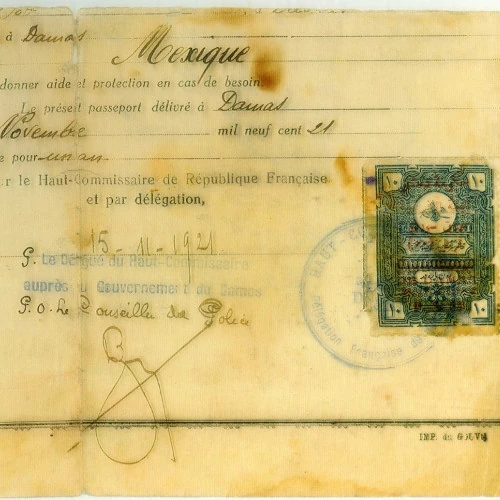The Semiotics of Djudeo-Espanyol in Recent Works by Myriam Moscona (pp. 110-121; DOI: 10.23692/iMex.14.9)
 Loading...
Loading...Prof. Dr. Darrell B. Lockhart
 Darrell B. Lockhart received his PhD from Arizona State University (1995) in Latin American literature and Jewish studies. Since 1999 he has taught courses in Latin American literature, popular culture and film at the University of Nevada, Reno, where he held the position of Chair of the Department of Languages and Literatures for five years and is currently Vice-Dean of the Faculty of Humanities, Arts and Social Sciences. His research focuses mainly on Judeo-Latin American literature and cultural production. He has several publications in this field that include his foundational book Jewish Writers of Latin America: A Dictionary (1997) and more recently edited and compiled the book Critical Approaches to Judeo-Mexican Literature (2013), as well as articles and essays published in Latin America, United States, and Europe. In addition to being a literary critic, he is a translator into English of texts by several Argentine authors such as Marcelo Birmajer, Carlos Chernov, Mempo Giardinelli and Manuela Fingueret. His translation of the novel Hija del silencio (Daughter of Silence) by Fingueret was named one of the best translations of the year 2013 by World Literature Today. Lockhart is co-president of the Latin American Jewish Studies Association (LAJSA).
Darrell B. Lockhart received his PhD from Arizona State University (1995) in Latin American literature and Jewish studies. Since 1999 he has taught courses in Latin American literature, popular culture and film at the University of Nevada, Reno, where he held the position of Chair of the Department of Languages and Literatures for five years and is currently Vice-Dean of the Faculty of Humanities, Arts and Social Sciences. His research focuses mainly on Judeo-Latin American literature and cultural production. He has several publications in this field that include his foundational book Jewish Writers of Latin America: A Dictionary (1997) and more recently edited and compiled the book Critical Approaches to Judeo-Mexican Literature (2013), as well as articles and essays published in Latin America, United States, and Europe. In addition to being a literary critic, he is a translator into English of texts by several Argentine authors such as Marcelo Birmajer, Carlos Chernov, Mempo Giardinelli and Manuela Fingueret. His translation of the novel Hija del silencio (Daughter of Silence) by Fingueret was named one of the best translations of the year 2013 by World Literature Today. Lockhart is co-president of the Latin American Jewish Studies Association (LAJSA).
The present essay examines the semiotics of Djudeo-Espanyol in the novel Tela de sevoya (2012) and the poetry collection Ansina (2015) by Myriam Moscona. While in some of her previous volumes of poetry Moscona explores her Sephardic identity—in part through language—in these two recent works Djudeo-Espanyol takes center stage not only as a marker of identity, but as integral to the process of liteary creation. In both the autobiographical novel and the volumen of poetry, the use and function of Djudeo-Espanyol in conjunction with Spanish, or as the sole language (as is the case with Ansina), communicates and indeed performs language in unique ways. The objective of the essay is to explore the mulitple ways in which Djudeo-Espanyol, as a language of creation and as affective linguistic register, transfers meaning to the reader.
El presente ensayo examina la semiótica del djudeo-espanyol en la novela Tela de sevoya (2012) y el poemario Ansina (2015) de Myriam Moscona. Mientras en algunos libros de poesía anteriores Moscona explora su identidad sefardita—en parte a através del lenguaje empleado—en estas dos obras recientes el djudeo-espanyol se destaca no solo como símbolo de la identidad, sino como integral al proceso de la creación literaria. Tanto en la novela autobiográfica como en el poemario el uso y la función del djudeo-espanyol en conjunción con el español, o como idioma único (como es el caso de Ansina), comunica y hasta toma aspectos performativos de la lengua. El objetivo de este ensayo es explorar las múltiples maneras en que el djudeo-espanyol, como una lengua de creación y como un registro lingüístico afectivo, transmite significado al lector.
Jacobo Sefamí / Matthias Lehmann - Editorial
Procesos inquisitoriales novohispanos. Nuevas aproximaciones
Antonio Cortijo Ocaña - El proceso contra Margarita Moreira
Ronnie Perelis – Reimagining the life of Luis Carvajal
Alicia Gojman - Guillén Lamport en la Nueva España
Experiencias migratorias de los judíos sirios y paralelismos con los libaneses maronitas. Perspectivas históricas
Carlos Martínez Assad - La memoria en la construcción de identidad
Liz Hamui - Narrativas de integración
La avidez de conocimiento universal en la literatura fundacional de tres escritoras judeo-mexicanas
Sara Poot Herrera - Margo Glantz: razón y corazón
Leonardo Senkmann - Figuraciones y fulguraciones en Esther Seligson
Darrell B. Lockhart - Semiotics in Myriam Moscona
Creation
Evocaciones del entorno sefardí
Myriam Moscona - Los guantes negros
Jacobo Sefamí - En Estambol te vo a bushkar
Interview


